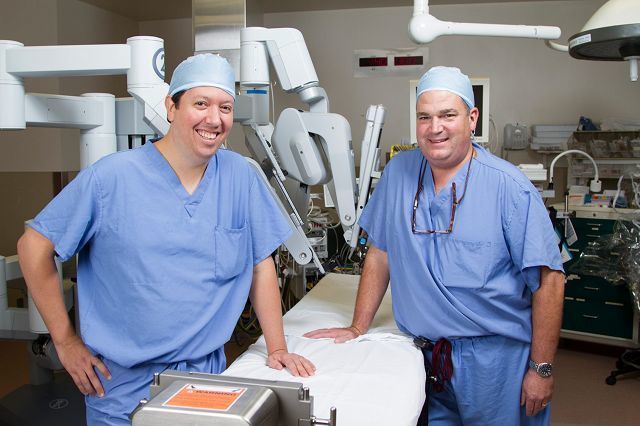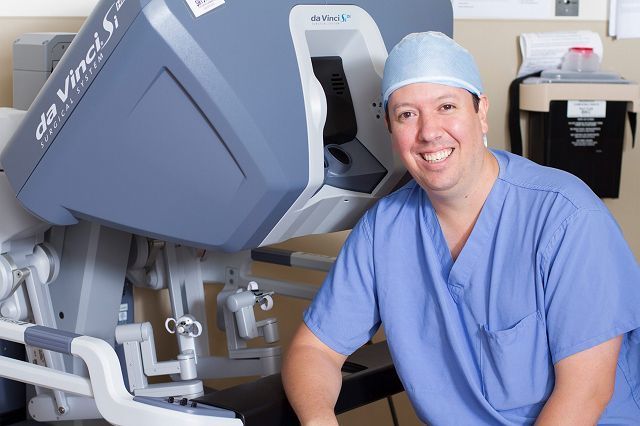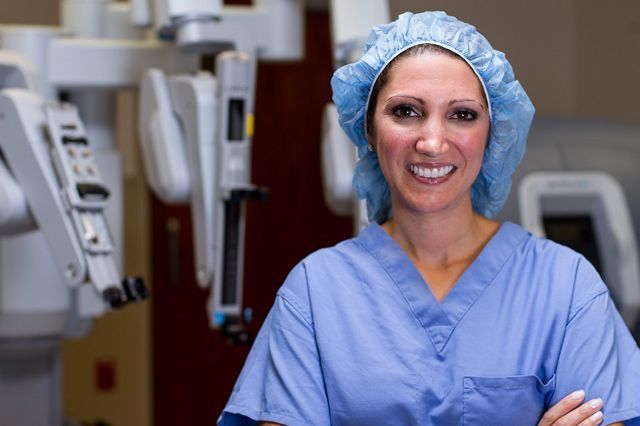Medicine goes space age at Wooster Community Hospital
Medicine has come a long way, and many of today's technologies look like something straight out of Star Trek. Wooster Community Hospital's new Da Vinci Surgical System is a case in point. Four spider-like robotic arms can perform intricate surgeries while the surgeon views a 3D image and manipulates the arms at a separate console.
"It's a little R2-D2," said Lori Hartzler, OR/Sterile Processing Manager at WCH. "When I started here in 1983, everything was done with open incisions. We moved to laparoscopic in the late 1980s and now to robotics." said Lori Hartzler, OR/Sterile Processing Manager at WCH.
Dave Rhoad, Marketing/PR Manager, said the hospital has added many new technologies in recent years, including WCH eCare, an online patient portal; low-dose imaging; heart catheterizations performed through the wrist; and hip arthroscopy, now offered by Dr. Anne Marie Chicorelli.
In addition, WCH received recognition from HIMSS Analytics for their IT work with the adoption of an Electronic Medical Record system. "All of these services/recognitions, whether they have the same "wow" factor or not, impact patient care and access to information in dramatic new ways," said Rhoad.
"Tech-wise, we're very far ahead for a small community hospital," Hartzler noted. "When equipment gets outdated, we have no problem upgrading."
Thanks to Wooster Community Hospital's new Da Vinci Surgical System, robotically assisted surgery is now available in Wooster.
The robotic system can be used to perform minimally invasive surgeries. It provides the surgeon with the precision and control of a traditional, open surgery yet requires only small incisions.
Four interactive robotic arms hold miniaturized instruments and a camera. The surgeon inserts them into the patient's body, and then moves to a console where a magnified, high-definition 3D image offers better visualization than traditional laparoscopic tools. This enhanced image is particularly helpful in fine surgeries such as cancer surgery, said Lori Hartzler, OR/Sterile Processing Manager at WCH.
To perform the surgery, the surgeon manipulates a set of master controls that work like forceps. His or her hand, wrist and finger movements control precise micro-movements of the robotic instruments while staff monitors the patient.
Although it may sound a little scary to have a robot performing surgery, there is actually nothing automated about it. "The robot is not actually doing the surgery—the surgeon drives the robot," said urologist Juan Proaño, M.D. one of the surgeons using the Da Vinci equipment. "The surgeon is still the surgeon. The robot is a tool that allows us to do greater things without opening the patient up." The robot cannot move unless the physician moves it. There is also an emergency stop button on the console arm itself. "There are a lot of fail-safes to it," Hartzler said.
One advantage of the robotic equipment is consistency, Hartzler said. Because its moves are always the same, it eliminates the human factor. Using robotics can lead to a more comfortable recovery because the incisions are small. It is also more exacting, so less healthy tissue is removed.
In addition, the wristed instruments can turn corners, allowing the surgeon to tackle more challenging tumors without having to open up the patient, Dr. Proaño said. Another advantage of the robotic equipment is that the instruments are wristed, offering a better working angle than typical straight laparoscopic instruments.
The robotic surgical system arrived at WCH in June, and the first surgeries took place in August. "We needed to make sure our staff were all trained," Hartzler said. "Da Vinci came in for a week of training and we traveled to other hospitals to observe them using the equipment. Then we did a number of dry runs to make sure we had everything in place."
Four surgeons in Wooster are now trained to use the equipment. "Dr. Proaño was already doing these surgeries at Mercy and Dr. Vandevelde was already trained, which helped get our program up and running," said Hartzler. "Dr. Shriner and Dr. Peabody are now also doing robotically assisted surgeries."
Hospital CEO Bill Sheron said requests from surgeons spurred the purchase of the robotic system. "Several years ago, Dr. Proaño, who had just come to Wooster, asked if we would consider purchasing a surgical robot. These robots were becoming commonly used in his specialty, urology, and he had trained on one of these devices. At the time, we really couldn't justify buying this equipment for the use of one physician. Perhaps a year later, we were approached by Dr. Vandevelde, who had recently come to Wooster and had also trained in robotically assisted surgery in her specialty (OB/GYN). When a third physician in a third specialty, Dr. Peabody, inquired, we felt we could have sufficient utilization to make such a purchase feasible.
"Our feeling is that robotic assisted surgery has benefits for certain surgical procedures and patients, and many medical residency training programs are now offering it. As we looked into the future, and in keeping Wooster Community Hospital at the forefront of new medical technology, we felt that robotically assisted surgery would help us attract and retain surgical specialists going forward. We have also observed the trend across the nation that an increasing number of community hospitals, like WCH, offer this service," said Sheron.
"Patients who were previously going to other institutions to have robotically assisted surgery done can now have it done here in Wooster," Hartzler noted. "Most places that have robotics are much larger hospitals—we're very lucky to have it and to have physicians trained to use it!"
For more information on robotically assisted surgery at Wooster Community Hospital, visit http://www.woosterhospital.org or call 330-263-8100.






